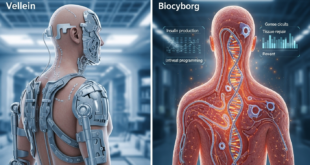This is the age of multidisciplinary frontiers in science and technology where major breakthroughs are likely to occur at the interfaces of disciplines.
Light has always fascinated mankind and since the beginning of recorded history, it has been both a subject of research and a tool for the investigation of other phenomena. Today, with the advent of nanotechnology, the use of light has reached its own dimension where light-matter interactions take place at wavelength and subwavelength scales and where the physical/chemical nature of nanostructures controls the interactions. The interface of photonics with nanotechnology has produced the field of nanophotonics which deals with light-matter interactions on nanoscale. Nanophotonics covers a diverse range of topics dealing with near field microscopy, nanoscale optical materials, and nanofabrication,
Nanophotonics deals with the interaction of light with matter at a nanometer scale, encompassing the study of new optical interactions, materials, fabrication techniques, and architectures, including the exploration of natural and synthetic, or artificially engineered, structures such as photonic crystals, holey fibers, quantum dots, subwavelength structures, and plasmonics.
Nanotechnology is the cutting-edge field of designing, producing, and manipulating materials and devices at the atomic and molecular scale. Biophotonics is a field that uses photons of light to image, identity, and engineer biological materials. The use of photonic nanotechnologies in medicine is a rapidly emerging and potentially powerful approach for disease protection, detection, and treatment. The high speed of light manipulation and the remote nature of optical methods suggest that light may successfully connect diagnostics, treatment, and even the guidance of the treatment in one theranostic procedure combination of therapeutics with diagnostics (including patient prescreening and therapy monitoring).
Together, nano-biophotonics is an emerging multidisciplinary field that combines the application of nanotechnology, biomedical science, and photonics to guide scientific investigations and engineer innovative solutions to real-world problems. It provides multidisciplinary opportunities for biological sensing, imaging, and a new form of optical diagnostics as well as light-guided and activated therapies. The use of nanophotonics in biomolecular interactions—nanobiophotonics—has prompt for a plethora of molecular diagnostics and therapeutics making use of the remarkable nanoscale properties.
Light can penetrate biological tissues non-invasively. Most of the available bio-optic tools are bulky. With the advent of novel nanotechnologies, building on-chip integrated photonic devices for applications such as sensing, imaging, neural stimulation, and monitoring is now a possibility. These devices can be embedded in portable electronic devices such as cell phones for point of care diagnostics.
Nano-biophotonics consists of four broad areas: molecular bioimaging; nano-bio sensors; multiplexed bioassays; and nanotechnology-based medical practices for diagnosis and therapy. Success in these areas is challenged by the underlying complexity of biological systems.
Soft- and bio-nano materials offer a high level of diversity and tunability in their structures to be employed in nanobiophotonics. As a matter of fact, nanostructures such as two-dimensional nanosheets and other nanoscale building blocks, exhibit exciting functions such as an enormous surface-to-volume ratio and unique optical, chemical, and electronic properties. These functions enhance the ability of metallic or semiconducting nanomaterials to absorb, reflect and interact with light, which is of the primary importance of developing nanophotonics, where photonics merges with nanoscience and nanotechnology.
Photonics and nano-biosciences are correlated. On the one hand, photonics provides a powerful set of tools to investigate nano bioscience and related novel materials. On the other hand, the investigation of optical linear and nonlinear properties of these materials certainly widens the frontier of the most recent photonics achievements.
Moreover, these materials can easily be engineered and functionalized, thus modifying their organization at the nanoscale, and consequently their physico-chemical properties. The tumultuous advances in understanding the behavior of soft matter and biomaterials at a molecular level, with the help of photonics techniques, are being actively translated into functional materials systems and devices, which take advantage of newly discovered and specifically created morphologies with desired properties.
Nanophotonics For Diagnostics
Surface plasmons are collective charge oscillations that occur at the interface between conductors and dielectrics. They can take various forms, ranging from freely propagating electron density waves along metal surfaces to localized electron oscillations on metal nanoparticles (NPs). When light passes through a metal nanoparticle, it induces dipole moments that oscillate at the respective frequency of the incident wave, consequently dispersing secondary radiation in all directions.
When light interacts with a substance, it can be absorbed, transmitted, or scattered. Scattered radiation can result from an elastic collision (Rayleigh scattering) or inelastic (Raman scattering). Raman spectroscopy is based on a change of frequency when light is inelastically scattered by molecules or atoms resulting in molecular fingerprint information on molecular structure or intermolecular interaction of a specific process or molecule. The potential of Raman spectroscopy as biomedical diagnostics tool is rather low due to its low cross-section (~10−30 cm2) which results in low sensitivity. However, the use of noble metal surfaces to enhance the Raman scattering signal of target molecules—Surface enhancement raman spectroscopy (SERS). Jeanmaire and Van Duyne proposed a twofold electromagnetic field enhancement that was later associated with the interaction between the incident and scattered photons with the nanostructure’s LSPR
SERS can also be used in conjunction with colloidal gold to detect and target tumors in vivo, where the AuNPs are surrounded with Raman reporters that provide light emission 200 times brighter than quantum dots
Quantum dots (QDs) are semiconductor nanoparticles with narrow, tunable, symmetrical emission spectra, and high quantum yields, and together with compatibility with DNA and proteins, make QDs exceptional substitutes as fluorescence labels.
Nanophotonics Bioimaging
Nanoparticles show unique features suitable for biomedical imaging applications, such as an increased sensitivity in detection through amplification of signal changes (e.g., magnetic resonance imaging); high fluorescence quantum yields and large magnetic moments; properties that induce phagocytosis and selective uptake by macrophages (e.g., liposomes); physicochemical manipulations of energy (i.e., quantum dots); among others
Because light absorption from biologic tissue components is minimized at near-infrared (NIR) wavelengths, most nanoparticles (e.g., noble metal and magnetic NPs, nanoshells, nanoclusters, nanocages, nanorods and quantum dots) for in vivo imaging and therapy have been designed to strongly absorb in the NIR and used for in vivo diagnostics
Nanophotonics for Therapy
Nanophototerapy uses pulsed lasers and absorbing nanoparticles attached to specific targets for selective damage to cancer cells. Plasmonic photothermal therapy (PPTT) and photodynamic therapy (PDT) are two of the main techniques that take advantage of the selective absorbance of the surface plasmon resonance and the fact that the nanoparticles relax by liberating heat into their surrounding environment.
Light-Controlled Nanoparticles Support Noninvasive Nanomedicine
Scientists from ITMO University have developed a production method for bio-integrated optical nanomaterials based on Mie-resonant silicon nanoparticles. The nanoparticles used in the work are covered by biopolymer shells and can be controlled by heat. With light irradiation, the particles change their shape and color. The discovery is poised to support nanophotonic and nanomedicine applications and the development of noninvasive biosensors, signal systems, and nontoxic dyes.
Though the issue of controlled nanomaterials is resolved, existing systems that rely on them can be toxic to living organisms, which limits the scope of their application in medicine and biology. The ITMO researchers’ material is fully biocompatible, with controllable properties. “The nanoparticles are composed of silicon cores and biopolymer shells,” said Anna Nikitina, a staff member at ITMO’s Infochemistry Scientific Center. “The substances that make up the shells possess different hydrophobic/hydrophilic qualities, i.e., the way in which their molecules react to water. We were able to use that to make the particles contract or expand depending on external factors.” Hydrophobic materials are those that repel water. Hydrophilic materials are wetted by and absorb water.
Because the nanoparticles change both their shape and color under thermal influences, they can be used, for example, to perform noninvasive local temperature measurements in biological tissue or to design sensor systems that can be used to analyze internal processes in living organisms. The nanoparticles can also be used as components of controllable systems that can be used to create thermo- and light-controlled dyes such as the liquid-crystal modulators used in holography and lithography.
Changes in the color of the particles occur due to structural transformations, and the controlled particles do not need to be paired with additional complex devices, such as ultrasensitive spectral sensors to collect data from within an organism, said Valentin Milichko, a staff member at ITMO University’s School of Physics and Engineering. “A simple change in color allows us to easily monitor what is happening to the particle in real time. The technology is multiuse, too. Each particle can be turned on and off several times,” Milichko said.
The researchers have been developing these controlled systems for three years; they previously experimented with various sizes and spatial characteristics of the nanoparticles, and they searched for polymers that would exhibit the desired performance. The systems’ efficiency has been confirmed only in laboratory conditions. The next step in the study will be in vitro testing, the researchers said.
Reusable Sensor Deploys Nano Antenna for Diagnosis, reported in Feb 2022
A tiny, reusable sensing chip developed by University of Buffalo researchers could lead to new point-of-care medical tests. The sensor uses surface-enhanced infrared absorption (SEIRA) spectroscopy, with technology that is based on nanostructures that are nearly as small as the biological and chemical molecules they aim to detect. Though these nanostructures improve a sensor’s ability to detect molecules, their tiny dimensions make it hard to guide the molecules to the correct area of the sensor.
The technology developed by the Buffalo team is designed to solve that problem; the sensors work with light in the mid-infrared band of the spectrum and consist of several arrays of tiny rectangular strips of gold. The strips are dipped in 1-octadecanethiol (ODT), the chemical compound that the researchers chose to identify.
They added a drop of liquid gallium, and, lastly, they placed a thin glass cover on top to form a sandwich-like structure. The design of the sensor, with its layers and cavities, creates what the researchers call a “nanopatch antenna.” The antenna both funnels molecules into the cavities and absorbs enough infrared light to analyze biological and chemical samples. “Even a single layer of molecule in our sensor can lead to a 10% change in the amount of light reflected, whereas a typical sensor may only produce a 1% change,” Liu said.
After measuring the ODT, the researchers removed the liquid gallium from the sensor chip surface with a swab. This process allows the sensor to be reused, which could make it more cost-effective than similar alternatives. “The structure of our sensor makes it suitable for point-of-care applications that can be implemented by a nurse on a patient, or even outside the hospital in a patient’s home,” Liu said. The team intends to continue to refine the sensor with the goal of using it for bioanalytical sensing and medical diagnostics applications, such as sensing biomarkers linked to certain diseases.
References and Resources also include:
https://www.photonics.com/Articles/Light-Controlled_Nanoparticles_Support/a66979
https://www.photonics.com/Articles/Reusable_Sensor_Deploys_Nano_Antenna_for_Diagnosis/a67773
 International Defense Security & Technology Your trusted Source for News, Research and Analysis
International Defense Security & Technology Your trusted Source for News, Research and Analysis



